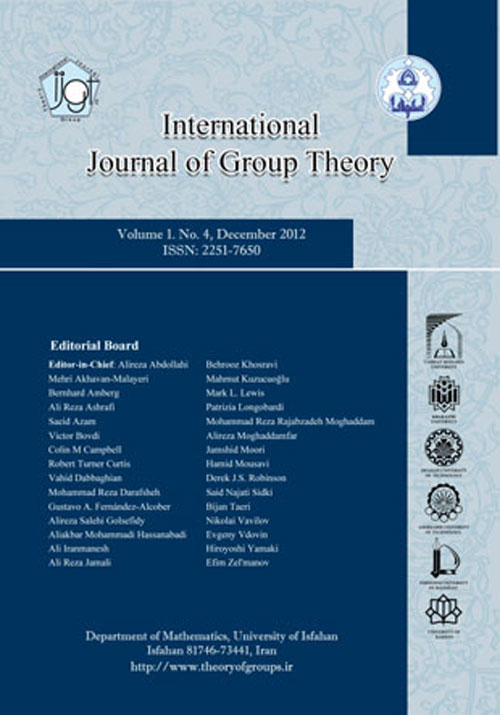فهرست مطالب

International Journal of Group Theory
Volume:8 Issue: 4, Dec 2019
- تاریخ انتشار: 1398/09/10
- تعداد عناوین: 5
-
-
Pages 1-3We say that a group $G$ satisfies the one-prime power hypothesis for conjugacy classes if the greatest common divisor for all pairs of distinct conjugacy class sizes are prime powers. Insoluble groups which satisfy the one-prime power hypothesis have been classified. However it has remained an open question whether the one-prime power hypothesis is inherited by normal subgroups and quotients groups. In this note we construct examples to show the one-prime power hypothesis is not necessarily inherited by normal subgroups or quotient groups.Keywords: Conjugacy classes, finite groups, restriction to substructures
-
Pages 5-9We establish the existence of two rigid triples of conjugacy classes in the algebraic group G2 in characteristic 5, complementing results of the second author with Liebeck and Marion. As a corollary, the finite groups G2(5^n) are not (2,4,5)-generated, confirming a conjecture of Marion in this case.Keywords: triangle groups, finite groups of Lie type, representation varieties
-
Pages 11-28Graham Higman published two important papers in 1960. In the first of these papers he proved that for any positive integer $n$ the number of groups of order $p^{n}$ is bounded by a polynomial in $p$, and he formulated his famous PORC conjecture about the form of the function $f(p^{n})$ giving the number of groups of order $p^{n}$. In the second of these two papers he proved that the function giving the number of $p$-class two groups of order $p^{n}$ is PORC. He established this result as a corollary to a very general result about vector spaces acted on by the general linear group. This theorem takes over a page to state, and is so general that it is hard to see what is going on. Higman's proof of this general theorem contains several new ideas and is quite hard to follow. However in the last few years several authors have developed and implemented algorithms for computing Higman's PORC formulae in special cases of his general theorem. These algorithms give perspective on what are the key points in Higman's proof, and also simplify parts of the proof. In this note I give a proof of Higman's general theorem written in the light of these recent developments.Keywords: PORC, $p$-group, enumerate
-
Pages 29-36In the space of marked groups, we determine the structure of groups which are limit points of the set of all generalized quaternion groups.Keywords: the space of marked groups, Gromov-Grigorchuk metric, generalized quaternion groups, universal theory, ultra-product
-
Pages 37-46We investigate prime character degree graphs of solvable groups. In particular, we consider a family of graphs $Gamma_{k,t}$ constructed by adjoining edges between two complete graphs in a one-to-one fashion. In this paper we determine completely which graphs $Gamma_{k,t}$ occur as the prime character degree graph of a solvable group.Keywords: Character degree graphs, solvable groups, families

